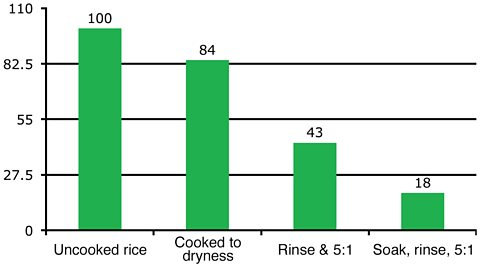Best Way To Remove Up To 82% Of Arsenic From Rice

Rice contains varying amounts of arsenic. Does soaking rice remove arsenic? The answer is yes – most of it – but read further for the recommended ways to remove it.
Not all rice contains high arsenic levels.
Rice with the least arsenic is Basmati rice from the foothills of the Himalayan Mountains, and Jasmine rice from Thailand:
Basmati Rice
(view on amzn)
Dynasty Jasmine Rice
(view on amzn)
How to Prepare & Cook Rice to Remove Most Arsenic
- Soak your rice overnight – this opens up the grain and allows the arsenic to escape
- Drain the rice and rinse thoroughly with fresh water
- For every part rice add five parts water and cook until the rice is tender – do not allow it to boil dry.
- Drain the rice and rinse again with hot water to get rid of the last of the cooking water.
Those instructions are sourced from a report via bbc.co.uk in association with Professor Andrew Meharg (Fellow of the Royal Society of Edinburgh, Member of the Royal Irish Academy).
Similar advice is recommended from other trusted sources listed below.
“Significantly higher geometric means of creatinine-corrected urinary concentrations of total arsenic (TAs) and dimethylarsinic acid (DMA) were found in participants who consumed rice more than twice per week, compared to the reference group.”
Rice consumption and urinary concentrations of arsenic in US adults
Should I be concerned about arsenic in Rice?
Yes, I believe so. Particularly if you consume rice more than two times a week. For some cultures, rice is a staple in their diets and arsenic is a major concern.
Being a preparedness site, I know that many people store white rice for the long term. It’s easy to store rice and it contains significant calories for those who prepare for food disruptions. Rice is a great combination with beans (nutritionally).
[ Read: Calories per pound of rice ]
[ Read: Rice & Beans | A Survival Combination ]
With that said, I felt it important to suggest adjustments to preparation and cooking of rice for those who may eat it fairly often.
Ratio of Water & Rice for Cooking to Help Remove Arsenic
During the cooking process, much of the arsenic leaves the rice and enters the cooking water.
If you cook your rice to dryness or use a rice cooker, the arsenic is absorbed back into the rice.
However, if you use more water, so that it is not all reabsorbed, much of the arsenic remains in the liquid instead (which can be discarded).
5 Parts Water | 1 Part Rice
Prof. Meharg’s testing found that when using 5 times as much water as rice when cooking, only 43% of the arsenic remained in the rice.
Combined with Rice Soak Overnight
When this method is combined with soaking the rice overnight before cooking, only 18% of the arsenic remained in the rice.

Rice With The Least Arsenic
“Until this all gets sorted out, consumers shouldn’t be overly concerned,” says John Duxbury, a soil chemist at Cornell University .
https://www.ncbi.nlm.nih.gov/pmc/articles/PMC1892142/
Nevertheless, rice fanciers might note that both Duxbury and Meharg found basmati rice imported from India and Pakistan and jasmine rice from Thailand to contain the least arsenic.
Take Home Message
Arsenic in rice may be a serious concern for those who consume it regularly.
These people may be at risk of developing arsenic-related health problems.
Though if you eat rice in moderation as a part of a varied diet, it will likely be a non issue.
If rice is a large part of your diet, make sure to follow the preparation and cooking advice given above to reduce arsenic from your rice.
Sources include:
consumerreports.org
healthline.com
bbc.co.uk
[ Read: Thermal Slow Cooker ]
